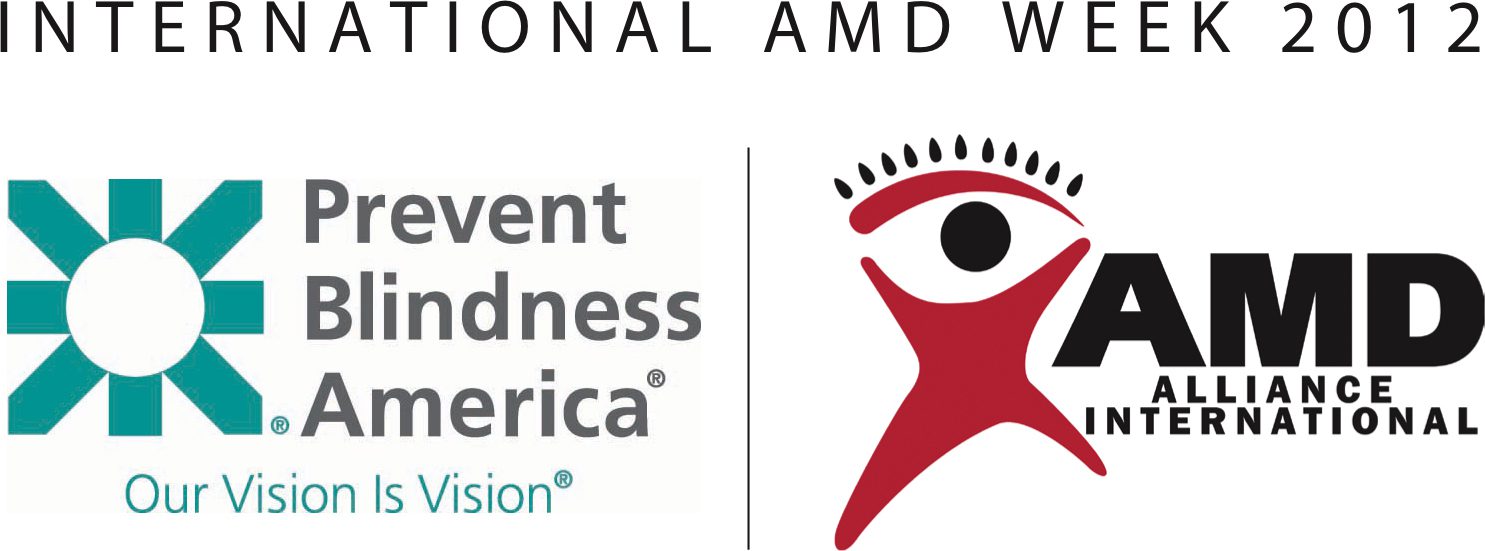Prevent Blindness America Joins Global Effort to Address Prevention Of Age-Related Macular Degeneration, the Leading Cause of Blindness In People Ages 50 and older
INTERNATIONAL AMD WEEK 2012- “PREVENTION”

CHICAGO (Sept. 19, 2012) – Age-related macular degeneration (AMD) is the leading cause of low vision and blindness in people over 50. It affects 25-30 million individuals in the Western world alone, yet very few are aware that AMD may be prevented by following a few very important suggestions.
In the United States, AMD affects more than 2 million people age 50 and older, according to the 2012 Vision Problems in the U.S. report from Prevent Blindness America and the National Eye Institute. And, that number is increasing every year as the population ages.
AMD occurs in a specialized portion of the retina called the macula. Abnormal blood vessels grow beneath the macula where they leak. This causes damage to cells that are responsible for our sharp central vision.
“The situation is alarming,” said Hugh R. Parry, president and CEO of Prevent Blindness America and chairman of the board of AMD Alliance International (AMDAI). “Too many people simply do not understand the risk factors that lead to AMD and the ways AMD can be prevented or slowed.”
“Everyone ages 40 and older should have a dilated eye exam and follow their eye doctor’s recommendation for regular eye exams, even if their vision seems perfect,” said Narinder Sharma, President and CEO of AMD Alliance International (AMDAI). “Education and early detection are key to preventing AMD or slowing its advance.”
In addition to regular eye exams, people can help prevent AMD through diet and lifestyle changes:
Pay attention to diet-Eat dark green, leafy vegetables and fish. NEI researchers found that people who eat food rich in lutein and zeaxanthin, two anti-oxidants from the same family as beta carotene, are at lower risk for AMD. These foods include kale, mustard greens, collard greens, and raw or cooked spinach, among others. When it comes to fish, they found that people whose diets contain a lot of omega-3 fatty acids (DHA and EPA found in fish, especially salmon) are also at less risk for advanced AMD. As little as one serving of fish per week may be helpful. Nuts, olive oil, and fruits are important, too. They also contain vitamins and minerals that play a role in AMD prevention.
Don’t smoke-In addition to the role of diet, research has shown that AMD is two to three times more likely among tobacco smokers, and that the risk is dose dependent. In other words, the more a person smokes, the greater the risk and the faster the progression of the disease. Controlling weight and cholesterol are also important.
Test vision using the Amsler grid- The Amsler grid resembles graph paper except for a dot in its center. It helps detect AMD or AMD progression. The user is instructed to hang the grid on the front of the refrigerator or in a similarly convenient location; to cover one eye; to look at the central dot with the uncovered eye; and notice whether any lines appear wavy or broken. If so, or if the lines look worse than before, it is important to see an eye doctor right away. Prevent Blindness America has free downloadable Amsler grids available at preventblindness.org/amsler-grid.
During International AMD Week, September 22-30, 2012, Prevent Blindness America and AMD Alliance International are launching a series of global initiatives and communications strategies to increase awareness of AMD prevention, including:
-
Prevent Blindness America provides free AMD information including preventive steps, risk factors and treatment options at preventblindness.org/amd or at (800) 331-2020.
- AMDAI is soliciting stories from thousands of people who have AMD. Using their own smartphones as a video camera, they will be asked to describe the impact of AMD on their life. This will become the germ of a repository for stories that can be accessed by other patients and by families, friends, and perhaps even social scientists who want to understand quality of life in AMD patients.
“We want people to understand that they can have a role in preventing AMD. This means make a commitment to regular dilated eye exams; use the Amsler grid for self-examination; don’t smoke and quit if you do; control cholesterol and weight; and make sure your diet is rich in the recommended foods,” says Sharma. “These behaviors can save the vision of millions of people. That is what makes the 2012 International AMD Week campaign so critical.”
About Prevent Blindness America
Founded in 1908, Prevent Blindness America is the nation's leading volunteer eye health and safety organization dedicated to fighting blindness and saving sight. Focused on promoting a continuum of vision care, Prevent Blindness America touches the lives of millions of people each year through public and professional education, advocacy, certified vision screening and training, community and patient service programs and research. These services are made possible through the generous support of the American public. Together with a network of affiliates, divisions and chapters, Prevent Blindness America is committed to eliminating preventable blindness in America. For more information, or to make a contribution to the sight-saving fund, call 1-800-331-2020. Or, visit us on the Web at preventblindness.org or facebook.com/preventblindness.
About AMD Alliance International
AMD Alliance International (AMDAI) is the only international organization in the world dedicated exclusively to promoting awareness, treatment, and research into macular degeneration, the leading cause of vision loss in the developed world. With more than 70 organizational allies in 25 countries, AMDAI is a membership organization comprised of world leaders in ophthalmology, vision, rehabilitation, research, and patient and senior’s advocacy. For more information, visit www.amdalliance.org.
Download a copy of the International AMD Week 2012 press release.
